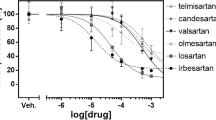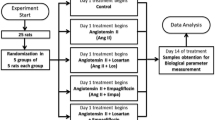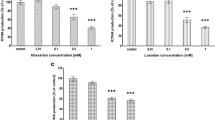Abstract
Background
The renin-angiotensin system (RAS) is commonly known to regulate blood pressure, water and electrolyte homeostasis, however it also exerts paracrine and autocrine actions on the kidney. Angiotensin-converting enzyme inhibitors (ACE-Is), alongside their hypotensive properties, have been shown to decrease kidney function decline in animal models of nephropathy.
Glutamate (GLU) is the main stimulatory neurotransmitter in the central nervous system, however its importance in the periphery should also be considered. Activation of renal GLU receptors has been linked to normal kidney function and also renal injury. The wide spectrum GLU receptor antagonist kynurenic acid (KYNA) possesses neuroprotective and central hypotensive effects, however its actions outside the brain are less well recognized. KYNA is a tryptophan metabolite synthesized from kynurenine by kynurenine aminotransferases (KATs). The purpose of this study was to examine the influence of three ACE-Is: lisinopril, perindopril and ramipril on KYNA production and KATs activity in rat kidney in vitro.
Methods
The effect of ACE-Is on KYNA production and KATs activity was examined in rat kidney homogenates. KYNA was detected by high-performance liquid chromatography (HPLC) and quantified fluorometrically.
Results
All examined ACE-Is: lisinopril, perindopril and ramipril decreased KYNA production in rat kidney in vitro. KAT I activity was decreased by lisinopril and ramipril whereas the activity of KAT II was lowered by ramipril.
Conclusion
Our study shows that ACE-Is can decrease KYNA production in rat kidney in vitro. Further studies are required to determine the clinical importance of the inhibitory action of ACE-Is on KYNA synthesis in the kidney.
Similar content being viewed by others
References
Nasri H, Rafieian-Kopaei M. On the occasion of world kidney day 2016; work together to better protect the kidney. J Nephropathol 2016;5(1):15–8.
Stanifer JW, Muiru A, Jafar TH, Patel UD. Chronic kidney disease in low- and middle-income countries. Nephrol Dial Transplant 2016;31(6):868–74.
Mizuiri S, Ohashi Y. ACE and ACE2 in kidney disease. World J Nephrol 2015;4 (1):74–82.
Viazzi F, Bonino B, Cappadona F, Pontremoli R. Renin-angiotensin-aldosterone system blockade in chronic kidney disease: current strategies and a look ahead. Intern Emerg Med 2016;11(5):627–35.
Portero-Otín M, Pamplona R, Boada J, Jové M, Gonzalo H, Buleon M, et al. Inhibition of renin angiotensin system decreases renal protein oxidative damage in diabetic rats. Biochem Biophys Res Commun 2008;368(3):528–35.
Schießl IM, Kattler V, Castrop H. In vivo visualization of the antialbuminuric effects of the angiotensin-converting enzyme inhibitor enalapril. J Pharmacol Exp Ther 2015;353(2):299–306.
Izzo Jr. JL, Weir MR. Angiotensin-converting enzyme inhibitors. J Clin Hypertens (Greenwich). 2011;13(9):667–75.
Dryer SE. Glutamate receptors in the kidney. Nephrol Dial Transplant 2015;30 (10):1630–8.
Szaroma W, Dziubek K, Kapusta E. Effect of N-methyl-D-aspartic acid on activity of superoxide dismutase, catalase, glutathione peroxidase and reduced glutathione level in selected organs of the mouse. Acta Physiol Hung 2014;101(3):377–87.
Pundir M, Arora S, Kaur T, Singh R, Singh AP. Effect of modulating the allosteric sites of N-methyl-D-aspartate receptors in ischemia-reperfusion induced acute kidney injury. J Surg Res 2013;183(2):668–77.
Du J, Li XH, Li YJ. Glutamate in peripheral organs: biology and pharmacology. Eur J Pharmacol 2016;784:42–8.
Gill SS, Pulido OM. Glutamate receptors in peripheral tissues: current knowledge, future research, and implications for toxicology. Toxicol Pathol 2001;29(2):208–23.
Leung JC, Marphis T, Craver RD, Silverstein DM. Altered NMDA receptor expression in renal toxicity: protection with a receptor antagonist. Kidney Int 2004;66(1):167–76.
Zhang C, Yi F, Xia M, Boini KM, Zhu Q, Laperle LA, et al. NMDA receptor-mediated activation of NADPH oxidase and glomerulosclerosis in hyperhomocysteinemic rats. Antioxid Redox Signal 2010;13(7):975–86.
Kemp JA, Foster AC, Leeson PD, Priestley T, Tridgett R, Iversen LL, et al. 7-Chlorokynurenic acid is a selective antagonist at the glycine modulatory site of the N-methyl-D-aspartate receptor complex. Proc Natl Acad Sci U S A 1988;85(17):6547–50.
Doi K, Tsumoto T, Matsunaga T. Actions of excitatory amino acid antagonists on synaptic inputs to the rat medial vestibular nucleus: an electrophysiological study in vitro. Exp Brain Res 1990;82(2):254–62.
Németh H, Toldi J, Vécsei L. Role of kynurenines in the central and peripheral nervous systems. Curr Neurovasc Res 2005;2(3):249–60.
Pawlak D, Tankiewicz A, Matys T, Buczko W. Peripheral distribution of kynurenine metabolites and activity of kynurenine pathway enzymes in renal failure. J Physiol Pharmacol 2003;54(2):175–89.
Liebig J. Über kynurensäure. Justus Liebigs Ann Chem 1853;86(1):125–6.
Zhao J, Chen H, Ni P, Xu B, Luo X, Zhan Y, et al. Simultaneous determination of urinary tryptophan, tryptophan-related metabolites and creatinine by high performance liquid chromatography with ultraviolet and fluorimetric detection. J Chromatogr B Analyt Technol Biomed Life Sci 2011;879(26):2720–5.
Schwarcz R, Speciale C, French ED. Hippocampal kynurenines as etiological factors in seizure disorders. Pol J Pharmacol Pharm 1987;39(5):485–94.
Németh H, Toldi J, Kynurenines Vécsei L. Parkinson’s disease and other neurodegenerative disorders: preclinical and clinical studies. J Neural Transm Suppl 2006;28(70):5–304.
Erhardt S, Olsson SK, Engberg G. Pharmacological manipulation of kynurenic acid: potential in the treatment of psychiatric disorders. CNS Drugs 2009;23 (2):91–101.
Ito S, Komatsu K, Tsukamoto K, Sved AF. Excitatory amino acids in the rostral ventrolateral medulla support blood pressure in spontaneously hypertensive rats. Hypertension 2000;35(1 Pt 2):413–7.
Araujo GC, Lopes OU, Campos RR. Importance of glycinergic and glutamatergic synapses within the rostral ventrolateral medulla for blood pressure regulation in conscious rats. Hypertension 1999;34(4 Pt 2):752–5.
Zakrocka I, Turski WA, Kocki T. Angiotensin-converting enzyme inhibitors modulate kynurenic acid production in rat brain cortex in vitro. Eur J Pharmacol 2016;789:308–12.
Sanmartín-Suárez C, Soto-Otero R, Sánchez-Sellero I, Méndez-Álvarez E. Antioxidant properties of dimethyl sulfoxide and its viability as a solvent in the evaluation of neuroprotective antioxidants. J Pharmacol Toxicol Methods 2011;63(2):209–15.
White CM. Pharmacologic, pharmacokinetic, and therapeutic differences among ACE inhibitors. Pharmacotherapy 1998;18(3):588–99.
Tsai HH, Lees KR, Howden CW, Reid JL. The pharmacokinetics and pharmacodynamics of perindopril in patients with hepatic cirrhosis. Br J Clin Pharmacol 1989;28(1):53–9.
Thomsen R, Rasmussen HB, Linnet K. INDICES Consortium: in vitro drug metabolism by human carboxylesterase 1: focus on angiotensin-converting enzyme inhibitors. Drug Metab Dispos 2014;42(1):126–33.
Meisel S, Shamiss A, Rosenthal T. Clinical pharmacokinetics of ramipril. Clin Pharmacokinet 1994;26(1):7–15.
Cushman DW, Wang FL, Fung WC, Grover GJ, Harvey CM, Scalese RJ, et al. Comparisons in vitro, ex vivo, and in vivo of the actions of seven structurally diverse inhibitors of angiotensin converting enzyme (ACE). Br J Clin Pharmacol 1989;28(Suppl. 2):115S–30S.
Grima M, Welsch C, Michel B, Barthelmebs M, Imbs JL. In vitro tissue potencies of converting enzyme inhibitors: prodrug activation by kidney esterase. Hypertension 1991;17(4):492–6.
Kaihara M, Price JM, Takahashi H. The conversion of kynurenic acid to quinaldic acid by humans and rats. J Biol Chem 1956;223(2):705–8.
Turski WA, Schwarcz R. On the disposition of intrahippocampally injected kynurenic acid in the rat. Exp Brain Res 1988;71(3):563–7.
Bergamaschi C, Campos RR, Schor N, Lopes OU. Role of the rostral ventrolateral medulla in maintenance of blood pressure in rats with Goldblatt hypertension. Hypertension 1995;26(6 Pt 2):1117–20.
Deng A, Thomson SC. Renal NMDA receptors independently stimulate proximal reabsorption and glomerular filtration. Am J Physiol Renal Physiol 2009;296(5):F976–82.
Smothers CT, Woodward JJ. Pharmacological characterization of glycine-activated currents in HEK 293 cells expressing N-methyl-D-aspartate NR1 and NR3 subunits. J Pharmacol Exp Ther 2007;322(2):739–48.
Sproul A, Steele SL, Thai TL, Yu S, Klein JD, Sands JM, et al. N-methyl-D-aspartate receptor subunit NR3a expression and function in principal cells of the collecting duct. Am J Physiol Renal Physiol 2011;301(1):F44–54.
Anderson M, Suh JM, Kim EY, Dryer SE. Functional NMDA receptors with atypical properties are expressed in podocytes. Am J Physiol Cell Physiol 2011;300(1):C22–32.
Roshanravan H, Kim EY, Dryer SE. NMDA receptors as potential therapeutic targets in diabetic nephropathy: increased renal NMDA receptor subunit expression in Akita mice and reduced nephropathy following sustained treatment with memantine or MK-801. Diabetes 2016;65(10):3139–50.
Shen J, Wang R, He Z, Huang H, He X, Zhou J, et al. NMDA receptors participate in the progression of diabetic kidney disease by decreasing cdc42-GTP activation in podocytes. J Pathol 2016;240(2):149–60.
Arora S, Kaur T, Kaur A, Singh AP. Glycine aggravates ischemia reperfusion-induced acute kidney injury through N-Methyl-D-Aspartate receptor activation in rats. Mol Cell Biochem 2014;393(1–2):123–31.
Yang CC, Chien CT, Wu MH, Ma MC, Chen CF. NMDA receptor blocker ameliorates ischemia-reperfusion-induced renal dysfunction in rat kidneys. Am J Physiol Renal Physiol 2008;294(6):F1433–40.
Lin CS, Hung SF, Huang HS, Ma MC. Blockade of the N-Methyl-D-Aspartate glutamate receptor ameliorates lipopolysaccharide-Induced renal insufficiency. PLoS One 2015;10(7):e0132204.
Parisi E, Bozic M, Ibarz M, Panizo S, Valcheva P, Coll B, et al. Sustained activation of renal N-methyl-D-aspartate receptors decreases vitamin D synthesis: a possible role for glutamate on the onset of secondary HPT. Am J Physiol Endocrinol Metab 2010;299(5):E825–31.
Foster AC, Kemp JA, Leeson PD, Grimwood S, Donald AE, Marshall GR, et al. Kynurenic acid analogues with improved affinity and selectivity for the glycine site on the N-methyl-D-aspartate receptor from rat brain. Mol Pharmacol 1992;41(5):914–22.
Bądzyńska B, Zakrocka I, Sadowski J, Turski WA, Kompanowska-Jezierska E. Effects of systemic administration of kynurenic acid and glycine on renal haemodynamics and excretion in normotensive and spontaneously hypertensive rats. Eur J Pharmacol 2014;743:37–41.
Walczak K, Zurawska M, Kiś J, Starownik R, Zgrajka W, Bar K, et al. Kynurenic acid in human renal cell carcinoma: its antiproliferative and antimigrative action on Caki-2 cells. Amino Acids 2012;43(4):1663–70.
Che R, Yuan Y, Huang S, Zhang A. Mitochondrial dysfunction in the pathophysiology of renal diseases. Am J Physiol Renal Physiol 2014;306(4):F367–78.
Mutsaers HA, Wilmer MJ, Reijnders D, Jansen J, van den Broek PH, Forkink M, et al. Uremic toxins inhibit renal metabolic capacity through interference with glucuronidation and mitochondrial respiration. Biochim Biophys Acta 2013;1832(1):142–50.
Giardino L, Armelloni S, Corbelli A, Mattinzoli D, Zennaro C, Guerrot D, et al. Podocyte glutamatergic signaling contributes to the function of the glomerular filtration barrier. J Am Soc Nephrol 2009;20(9):1929–40.
Leung JC, Ragland N, Marphis T, Silverstein DM. NMDA agonists and antagonists induce renal culture cell toxicity. Med Chem 2008;4(6):565–71.
Sekita-Krzak J, Visconti J, Wójtowicz Z, Zebrowska-Lupina I, Ossowska G, Klenk-Majewska B. Histological examination of the kidney after experimental administration of MK-801 and dexamethasone. Ann Univ Mariae Curie Sklodowska Med 2004;59(2):70–4.
Kaczorek E, Szarek J, Mikiewicz M, Terech-Majewska E, Schulz P, Małaczewska J, et al. Effect of feed supplementation with kynurenic acid on the morphology of the liver, kidney and gills in rainbow trout (Oncorhynchus mykiss Walbaum, 1792), healthy and experimentally infected with Yersinia ruckeri. J Fish Dis 2016, doi:https://doi.org/10.1111/jfd.12567.
Author information
Authors and Affiliations
Corresponding author
Rights and permissions
About this article
Cite this article
Zakrocka, I., Kocki, T. & Turski, W.A. The effect of three angiotensin-converting enzyme inhibitors on kynurenic acid production in rat kidney in vitro. Pharmacol. Rep 69, 536–541 (2017). https://doi.org/10.1016/j.pharep.2017.01.023
Received:
Revised:
Accepted:
Published:
Issue Date:
DOI: https://doi.org/10.1016/j.pharep.2017.01.023




